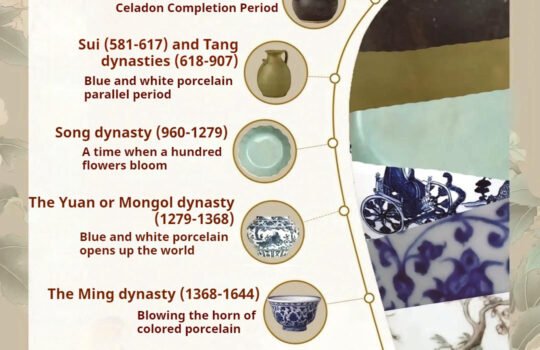14. Unraveling the Art of Blue and White Porcelain: A Peek Into the Craft of Chinese
The Origins of Blue and White Porcelain
The art of blue and white porcelain dates back to the Tang Dynasty (618–907 AD), but it was during the Yuan Dynasty (1271–1368) that it truly gained international fame. This style of porcelain, with its elegant cobalt blue designs painted on a white ceramic body, was soon recognized as a quintessential Chinese aesthetic. The color blue, created using cobalt ore from Persia, symbolized tranquility, immortality, and wisdom in Chinese culture. Over time, blue and white porcelain became a symbol of Chinese craftsmanship, with its allure extending far beyond the borders of China.
Crafting the Perfect Teacup: A Dance of Precision and Patience
Creating blue and white porcelain is no simple task. It involves a series of delicate steps, each requiring incredible skill and patience. The process begins with selecting the finest clay, which is then shaped into the desired form. Once the basic shape is formed, it is fired in a kiln at a high temperature to harden. The first firing is followed by the application of cobalt blue pigments, which are carefully hand-painted onto the surface of the porcelain.
The brushstrokes are where the magic happens. Artisans use fine brushes to apply intricate floral or geometric patterns, each design imbued with symbolism. Common motifs include peonies for wealth and prosperity, chrysanthemums for longevity, and lotus flowers representing purity. The blue pigments are applied with such precision that the slightest deviation can alter the entire pattern, showcasing the mastery of the artisan.
After the design is applied, the porcelain is glazed and fired again in a kiln. This second firing is crucial, as it bonds the cobalt pigments to the porcelain, ensuring the colors remain vivid and durable for centuries. The result is a piece of porcelain that is not only visually stunning but also long-lasting and functional.
The Aesthetic Appeal: A Symphony of Simplicity and Elegance
What makes blue and white porcelain so captivating is the perfect balance of form and function. The artistry of the hand-painted designs is complemented by the porcelain’s elegant, delicate form. The clean white background allows the intricate blue patterns to stand out, creating a sense of harmony and peace. It’s this blend of simplicity and complexity that draws admirers from all over the world.
In Chinese culture, blue and white porcelain isn’t just about beauty; it also carries deep cultural and philosophical meanings. The designs are often chosen for their symbolic value, with each element representing a different aspect of Chinese thought. For instance, the flowing lines of the design may represent the flow of life or the continuity of time. The overall harmony between the form and design speaks to the Chinese philosophy of balance, which is central to both art and life.
Symbolism and Cultural Significance
The cultural significance of blue and white porcelain extends beyond its artistic appeal. It’s a reflection of Chinese philosophy, history, and worldview. For centuries, blue and white porcelain has been used as a symbol of status and refinement. In the imperial courts, these teacups and other porcelain items were often gifted to high-ranking officials and foreign dignitaries, cementing their position as a symbol of both power and culture.
Blue and white porcelain also plays a key role in the Chinese tea culture. Tea, a staple of Chinese life, is not just about the beverage itself but the experience surrounding it. The teacup serves as both a vessel for tea and a symbol of harmony and peace. The careful preparation of tea, the contemplation of its aroma, and the elegance of the porcelain teacup all contribute to the meditative experience of tea-drinking. It’s a reflection of the broader values of balance, simplicity, and mindfulness in Chinese culture.
Modern Day: The Enduring Appeal of Blue and White Porcelain
Though blue and white porcelain has its roots in ancient China, its allure hasn’t faded over time. In fact, the craft continues to thrive today, with artisans and collectors worldwide still valuing its beauty and craftsmanship. Modern blue and white porcelain often combines traditional techniques with contemporary designs, resulting in stunning new pieces that maintain the timeless appeal of the classic style.
The blue and white porcelain teacup, in particular, has become an iconic representation of Chinese culture. It’s not just a functional object; it’s a piece of history, artistry, and philosophy. As collectors and tea enthusiasts seek out these exquisite pieces, the tradition of Chinese porcelain continues to evolve, staying relevant in a modern world while retaining the essence of its ancient roots.
Conclusion: A Legacy of Craftsmanship and Beauty
Blue and white porcelain is more than just an art form—it’s a living tradition that continues to connect the past with the present. From the intricate brushstrokes to the centuries-old techniques, every piece of blue and white porcelain tells a story of craftsmanship, culture, and beauty. Whether you’re enjoying a cup of tea or admiring its artistry, Chinese blue and white porcelain serves as a reminder of the timeless appeal of tradition, the elegance of simplicity, and the enduring value of fine craftsmanship.
As you sip from a delicate blue and white teacup, you’re not just experiencing a moment of refreshment—you’re also participating in a rich cultural legacy that has been passed down through generations. And in this way, the art of blue and white porcelain continues to live on, one cup at a time.





